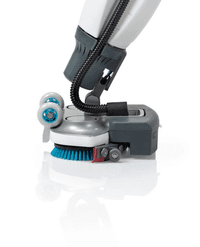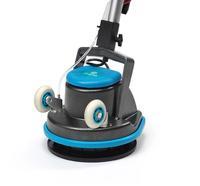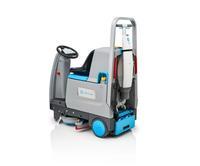You are reading: The Best Pads and Brushes for Your Floor Scrubber on 7 Different Floor Surfaces
15 August 2022
8min read time
Brooke Payne
The Best Pads and Brushes for Your Floor Scrubber on 7 Different Floor Surfaces
Share:

Key Insights
- Different types of floor pads and brushes are available for your i-mop depending on your type of flooring
- We recommend testing any brush pad or cleaning solution in a small inconspicuous area first
If you plan to clean various floor types with a floor cleaning machine in Australia or New Zealand, it’s crucial to research beforehand to avoid damaging surfaces. With so many brush and pad options available for floor scrubbers, choosing the right one for your specific floors can be challenging.
Thankfully, today we’re going to be unpacking your best options when it comes to cleaning a wide variety of floors, as well as which surfaces could be harmed with an incorrect brush or pad fitted to floor scrubbing machines.
While the examples we’ll be using in this piece utilise the brushes and pads from our i-mop range , these materials are commonly shared with different brands of floor scrubbers you might be using. Whether you’ve got a Tennant, Nilfisk, Taski or a Kärcher floor scrubber, these guidelines aren’t unique to the i-mop, as the range of brushes and pads contain common elements across all floor scrubbers.
With that in mind, let’s start unpacking the best brush options and pads for your floor cleaning machine that you should be using across seven distinct types of floors.
Vinyl and Lino Floors
Your typical modern vinyl floor receives a sealing finish from the factory, which means that you have several options when it comes to getting your vinyl and lino floors clear of scuffs. As a general rule, we suggest you stick with a pad, rather than a brush. This is largely because you’re more likely to remove those scuff marks with a pad than a brush.
This means that your best option for cleaning a vinyl floor with a floor scrubber is a green twister pad, followed by the red everyday cleaning pad. If the dirt or scuff marks are severe, you could even lean on a blue heavy duty cleaning pad to get to work lifting those marks.
If you’re dealing with a relatively low-traffic area in the house or workplace, a standard medium blue brush is perfect for the task, which could be complemented by the use of a red or blue pad periodically for a deeper clean.
You can see in our video that as our range of pads moves from white to black, the more aggressive their cleaning ability comes. White, for example, is known as our polishing pad, while red and blue are typically used for general cleaning, while green and black are normally reserved for stripping floors.
If you’re looking for an even greater level of cleaning, our range of twister pads have been designed with diamonds fitted to the surface. This makes them ideal for robust cleaning and polishing, while lasting up to six-times as long as traditional pads.
Concrete Floors
If you have concrete floors in your house that are attracting dirt, grease, and scuffs, you might have been frustrated in the past with stains that are difficult to lift off the surface. For concrete floors with a rough surface, a medium blue brush is perfect for the job, as well as a hard red brush fitted to your floor cleaning machine.
For smooth, polished concrete floors, opting for the green twister pad is likely your best option, otherwise you can also lean on the red or blue cleaning pad, depending on how stubborn the marks are. If you need to tackle dried up material that is sticking to the concrete floor surface, a hard brush will help to lift these.

Ceramic and Porcelain Tiles
There’s two ways to tackle dirt, stains and scuffs on ceramic and porcelain tiles, depending on the surface and finish that you’ve got in your home or workplace. For shiny, glazed tiles, a medium blue brush is your best option, considering these brushes can clean the grout lines within tiles, making them a great all-rounder.
If your ceramic or porcelain tiles have a flat, matte finish or are slightly textured, then leaning on a pad is a better option for these types of tiles. In this situation, pads offer a superior surface clean than brushes. A good idea, here, is to switch between your pads when cleaning your tiles to get a good initial surface clean, and then switch to a brush to effectively clean between the grout lines.
Natural Stone
If you’re looking to clean natural stone floors like terrazzo, marble or limestone, we would recommend the use of a green twister pad. This is because using a green twister pad helps to not only clean the surface, they also help to maintain, and even improve the gloss levels of the stone.
If you’re looking to clean natural stone floors that don’t attract any significant foot traffic, using a medium brush or red pad is completely fine for regular cleans and maintenance.

Epoxy Non-Slip
Epoxy non-slip floors are one of the most common types of floors you’ll find in the commercial sector, especially in the hospitality industry where non-slip kitchens are commonplace. For the most effective cleaning of your epoxy non-slip floors, we’d recommend the use of a soft blue brush, or a medium blue brush for your commercial floor scrubber. Just be mindful of the fact that rough floor surfaces can wear the harder brushes down.
Read how to choose a floor scrubber.
Timber Floors
Timber floors are one of the most attractive types of floor finish you can find, which means it’s imperative that we keep them fresh and clean. We’ve found that the best type of brush for cleaning high-gloss timber floors is the soft light-blue brush, or even a white polishing pad.
If you have timber floors that have more of a flat, matte finish, however, we believe you should be leaning on something like medium blue brush.
Rubber Floors
We’ve found that the best option for cleaning the rubber floors that you’ll commonly find in places like gyms is to utilise a natural fibre brush. This is an important consideration because natural fibres contacting a rubber floor create far less friction than a typical poly brush. Reducing the amount of friction between the device and your floor helps to minimise any stress on both the floor and your machine, which helps to ensure the longevity of your i-mop.
As you can see there's no one size that fits all, each floor has its own characteristics, however we've just tried to give you a general overview of the best mainstream solutions. If you're still unsure we'd always recommend testing any brush pad or cleaning solution in a small inconspicuous area first.
For any further questions please feel free to contact us directly.
Common Questions Answered
How do I choose a floor scrubber?
Choosing the right floor scrubber in Australia involves balancing productivity, space, and budget. If your budget allows and you have ample space, consider equipment with the widest cleaning path for maximum efficiency. For larger commercial spaces, ride-on scrubbers are a smart investment compared to walk-behind models, as their labour-saving benefits can quickly offset the higher upfront costs. Always evaluate the machine’s capacity, ease of use, and maintenance requirements to ensure it meets your cleaning needs effectively.
What's the life expectancy of a floor scrubber?
A quality machine can usually last between 5 to 10 years, though its actual lifespan depends on factors such as how intensively it's used, how regularly it's maintained, and the conditions in which it operates.
Why is my floor scrubber leaving streaks?
They may also become worn from repeated use. Damaged or worn blades can cause the scrubber to leave streaks or patches of water where the blade isn't level with the floor. The solution: Inspect the squeegee blade for any damage or wear.
References
https://www.sweeper.com.au/select-suitable-pads-and-brushes-for-floor-scrubbers/
https://www.sweeper.com.au/select-suitable-pads-and-brushes-for-floor-scrubbers/
Watch this video to see what's the best brushes or pads for cleaning different floor types
Products Featured Inside this Article
Media and Insights
Join the movement that's changing what clean means.
Be part of a cleaner world. Get a live demo at a time that suits you.
Book a Demo

